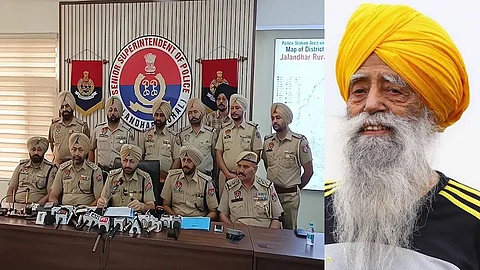

The Jalandhar Rural Police have quickly cracked the devastating hit-and-run case of the iconic 114-year-old marathon runner Fauja Singh by arresting Canada-based NRI Amritpal Singh Dhillon within 30 hours of the incident. The police used CCTV footage, witness statements, and a forensic report to identify and arrest the accused, who allegedly left the accident spot without providing any help to the victim.
As per police reports, the case has been
registered under sections 281 and 105 of the Bharatiya Nyaya Sanhita (BNS), India's revised criminal code. More seriously, the crime fits the newest, tougher provisions for hit-and-run offenses under Section 106 of the BNS, which was passed to replace the Indian Penal Code.
Rash and negligent driving causing death: Applicable under BNS Section 106.
Hit-and-run without reporting: The suspect is particularly charged with having fled the scene after causing the fatal accident, which is a serious crime under the new law.
The punishment for hit-and-run crimes has been greatly upgraded under the Bharatiya Nyaya Sanhita (BNS) to serve as an effective deterrent:
Section 106(1): This is the punishment where the driver kills due to rash or careless driving but promptly reports the accident to the authorities (magistrate or police). The law is appreciative of accepting responsibility and provides a relatively light sentence—5 years' imprisonment and a fine.
Section 106(2): This stricter provision is for those situations wherein the driver not only is involved in a fatal accident but also flees without reporting to authorities. Acknowledging the severity and irresponsibility of fleeing the scene, the law stipulates up to 10 years' imprisonment and a heavy fine, which can go up to ₹7 lakh.
These steps are intended to stimulate responsibility and prompt intervention to victims, making it starkly evident that evading the scene of a deadly accident has much more severe repercussions than remaining at the scene and notifying them.
Since Amritpal Singh Dhillon allegedly fled without reporting the incident to the authorities, he is prosecuted under Section 106(2):
Imprisonment for a term not exceeding 10 years
Significant financial fine, which can extend up to ₹7 lakh.
This amendment represents a serious increase from earlier legislation, which had a maximum of only two years' jail for the same crime. The intention is to make drivers help immediately and report accidents, because running away now has far more severe penalties.
Police highlighted accountability, observing, "If the accident was accidental, it was the responsibility of the driver to administer first aid and report the incident to the police. Running away with the vehicle turns a tragic mishap into a heinous crime."
With this case, law enforcers have sent a strong message regarding the punishments for hit-and-runs: faster investigations and harsher sanctions await violators who attempt to abdicate their responsibilities following serious accidents under the new regime.